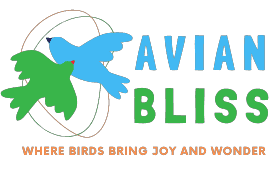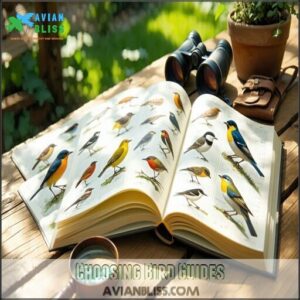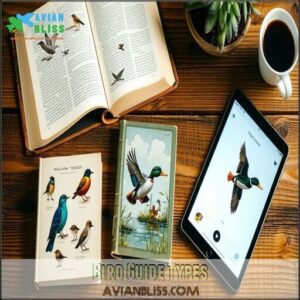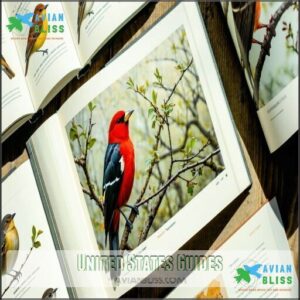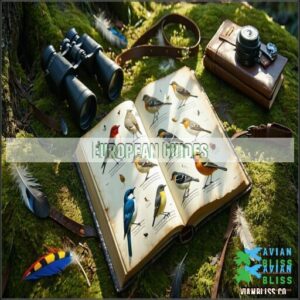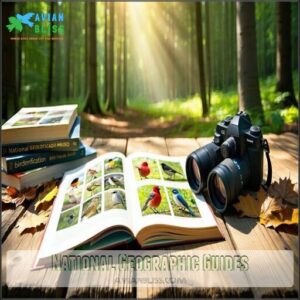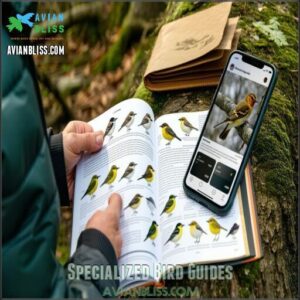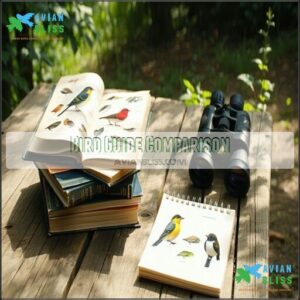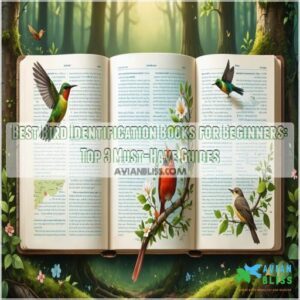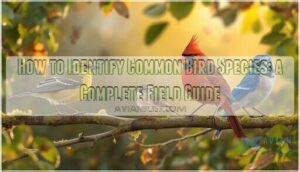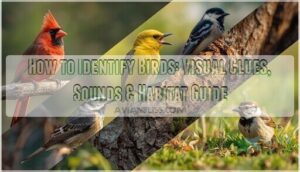This site is supported by our readers. We may earn a commission, at no cost to you, if you purchase through links.
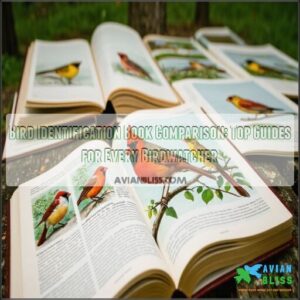
Exhaustive guides, like Sibley and Peterson, cover North America’s species in detail, with clear illustrations and maps.
If you’re more regional, compact options like Kaufman Field Guide or regional Audubon guides can save space and still deliver rich info.
Prefer photos over drawings? Kaufman blends simplicity with real-life images.
On a hike, a lightweight pocket guide works wonders.
For deeper insights, Sibley excels with detailed plumage comparisons.
Think of it like picking a tool—you want the right balance of size, visuals, and depth for your birdwatching adventures!
Table Of Contents
- Key Takeaways
- Choosing Bird Guides
- Bird Guide Types
- Key Features of Guides
- Regional Bird Guides
- Comprehensive Guides Overview
- Specialized Bird Guides
- Bird Guide Comparison
- Selecting Best Bird Guide
- Frequently Asked Questions (FAQs)
- How do I find the best bird identification book?
- Is a bird field guide a book?
- What is a good bird identification field guide?
- What is the best bird guide?
- How to identify birds accurately?
- What should you look for in a bird ID guide?
- What is the best book for bird identification?
- What is the best website to identify birds?
- Can I upload a picture of a bird to identify it?
- Is there an app to take a picture of a bird and identify it?
- Conclusion
Key Takeaways
- Think about your needs—regional guides work best for local birdwatching, while comprehensive ones are great for travelers.
- Decide if you’d rather have illustrations for details or photos for realistic visuals; both have unique strengths.
- Portability matters—pocket guides are handy for hikes, while apps offer instant identification but rely on a device.
- Look for extra features like range maps, seasonal plumage variations, and habitat details to boost your birding skills.
Choosing Bird Guides
When choosing a bird guide, you’ll want to ponder how much detail you need and whether a regional or exhaustive guide fits your birding habits.
Focus on features like portability, illustrations, and cost to find one that suits your style and location.
Regional Vs Comprehensive Guides
Deciding between a regional bird guide and an exhaustive guide depends on your birding travel and goals.
Regional guides focus on local detail, highlighting species abundance for beginner birders, with excellent portability.
Exhaustive guides, like a North American bird guide or a European bird guide, offer broad geographic coverage, perfect for travelers exploring varied habitats.
Backyard bird guides can further assist in identifying local species, helping you choose based on your plans and needs to become a better beginner birder with a good regional guide.
Key Features of Bird Identification Books
A great bird identification book should blend practicality with precision.
Look for these features to boost your birding skills:
- Identification accuracy: Detail-rich descriptions and illustrations.
- Species range maps: See where birds live or migrate.
- Taxonomic order: Logical layouts make finding birds easier.
- Conservation status: Stay informed about endangered species.
- Habitat information: Identify birds based on their surroundings.
Choose wisely, and your bird ID book becomes an irreplaceable field companion.
Cost Considerations for Bird Guides
Cost is a big factor when choosing a bird identification guide. Prices vary widely, so think about your needs and budget.
Used guides, rentals, or digital options can save money. Here’s a quick comparison:
| Option | Pros | Cons |
|---|---|---|
| Used Guides | Affordable, eco-friendly | May show wear |
| Digital Options | Portable, low-cost | Needs a device |
| Rental Programs | Budget-friendly short-term | Limited availability |
Every dollar counts in budget birding, so explore affordable choices! Consider what works best for you, and remember that every dollar counts in making the most of your birding experience with the right identification guide.
Bird Guide Types
Bird guidebooks come in all shapes and sizes, each offering something unique to birdwatchers.
From classic printed guides to sleek digital resources, the type of bird field guide you pick can shape your birding adventures.
Printed guides, like traditional or folding guides, are a favorite for their tactile feel and practicality in the field.
Folding guides, for example, condense key bird identification features into a lightweight, easy-to-carry format, making them perfect for quick reference.
If you’re into technology, digital resources like apps and online databases provide instant access to bird calls, high-quality photos, and updated species lists.
To further refine visual identification, consider observing beak shapes and leg colors.
Specialized guides, on the other hand, focus on narrow niches—think waterfowl only or a regional focus that helps you hone in on specific birds in your area.
A thoughtful bird guidebook review helps you figure out which format matches your style in this vast birding guide comparison.
Key Features of Guides
When you’re choosing a bird guide, understanding its key features helps you pick the right one for your style and needs.
Factors like whether it uses illustrations or photos, how thorough it is, and its portability can make all the difference.
Illustrations Vs Photos
When comparing visual aids in bird guides, illustrations emphasize detail clarity and can use artistic license for realism accuracy, highlighting key features like feather patterns.
Illustrations in bird guides highlight feather patterns with artistic clarity, offering unmatched detail for easier and more accurate bird identification.
Photographs, though, capture true-to-life bird photos, ideal for identification ease in the wild.
Your choice depends on personal preference: do you value curated bird illustrations or realistic snapshots, considering the unique strengths each offers for birdwatchers.
Both offer unique strengths for birdwatchers.
Comprehensiveness of Guides
When choosing a bird identification guide, a thorough guide offers unmatched Species Coverage and Identification Accuracy.
Look for these elements:
- Detail Level: Detailed illustrations or photos enhance Taxonomic Depth.
- Guide Updates: Regular editions guarantee evolving information about bird species.
- Species Depth: Covers regional and migratory birds thoroughly.
Thorough field guides maximize your birding experience by combining science with usability.
Size and Portability
Field guides come in all shapes and sizes, but portability is key for birdwatchers on the go.
Pocket guides and lightweight options are perfect for quick trips, while backpacking birds might require durable printed guides.
Smartphone apps and digital guides lighten your load and offer convenience, though durability concerns with devices in rugged conditions can arise during outdoor adventures.
Regional Bird Guides
When you’re birdwatching in a specific area, a regional guide helps you identify local species with ease.
These guides focus on birds you’re most likely to encounter, offering detailed insights customized to your location.
United States Guides
When birding across the United States, regional variations make specific guides invaluable.
Eastern guides, like the Peterson Guide, shine for beginners with focused details, while the Sibley Guide offers broader North American coverage.
Western guides cater to unique habitats, and Texas guides highlight local species.
These field guides balance portability and detail, making bird identification enjoyable and frustration-free.
Using a guide with detailed illustrations aids bird identification, providing broader North American coverage and making it frustration-free.
European Guides
When exploring Europe’s avian diversity, a regional guide like the Collins Bird Guide provides excellent European coverage.
It’s packed with detailed illustrations, precise maps, and notes on migration patterns.
The BTO Guide focuses on birds of the region, highlighting rare species and local nuances.
For thorough field guides, these resources balance portability with essential details on Europe’s rich birdlife.
Many resources, like the European bird guide, are available online, making it easier to access detailed illustrations and precise maps.
Australian and Oceania Guides
Australia and Oceania offer unparalleled birdwatching, with field guides aiding your adventures.
Look for ones highlighting:
- Endemic Species—unique island variations like kiwis and cassowaries.
- Habitat Coverage—essential for diverse ecosystems.
- Guide Illustrations—crisp, detailed visuals matter.
- Conservation Status—key for endangered birds.
For further reading, explore available bird guide options online.
- Top Picks—The Australian Bird Guide stands out, while Birds of Oceania balances portability and detail.
Comprehensive Guides Overview
When you’re ready to explore bird species across vast regions or even entire continents, thorough guides are an essential tool.
These books, like those from National Geographic, Sibley, and Peterson, offer detailed coverage, helping dedicated birdwatchers confidently identify a wide range of species.
National Geographic Guides
The National Geographic Field Guide is a standout for its Geographic Accuracy and detailed Species Range maps, regularly updated with eBird data.
Renowned for photography quality, it attracts all audiences, from hobbyists to experts.
These field guides blend visuals with concise facts, making birdwatching books and bird identification easier.
In any bird guide comparison, these updates set a gold standard.
Novices can improve by practicing regularly, which is a key aspect of mastering bird identification.
Sibley Guides
With its stunning Sibley illustrations and focus on species range, the Sibley Guide sets the gold standard in birdwatching books.
Covering 810 species, it excels in identification accuracy, offering detailed updates on behavior and habitat.
Sibley’s approach emphasizes clarity, featuring multiple poses and in-flight depictions.
Durable and thorough, it’s a must-have bird identification book for both casual birders and seasoned experts.
Peterson Guides
Switching from Sibley Guides, the Peterson Guide stands out for its unique Identification System.
With clear illustrations, range maps, and a reputation for beginner friendliness, it’s a favorite in bird identification book comparisons.
Eastern/Western Guides cater to specific regions and practical field use.
- Why It’s Loved: Clear Peterson illustrations and labelled features.
- Regional Options: Eastern and Western versions stand out.
- Versatile: Great for beginners or seasoned birdwatchers.
Specialized Bird Guides
If you’re looking for bird guides suited to specific needs, specialized options like folding, digital, and traditional guides can offer unique advantages.
These guides focus on practicality and feature formats designed for convenience, portability, or advanced identification.
Folding Guides
Folding bird field guides are perfect for quick reference in the field, offering excellent portability advantages.
They’re lightweight and compact, making them easy to carry during birding trips. Ideal for beginners and casual birders, these guides focus on localized species inclusion.
Many birders find them to be essential field equipment, which can be considered long-lasting bird identification book alternatives. However, durability concerns arise with frequent use, so choose wisely if you need one.
Digital Bird Guides
Printed guides are classic, but technology adds new tools.
Bird identification apps are game-changers:
- App features like sound identification and community sharing make birdwatching richer.
- Offline access guarantees functionality in remote spots without service.
- Digital updates keep birding apps current with species info, images, and calls.
These birdwatching apps bring nature closer, right from your pocket!
Traditional Guides
Traditional bird guides embrace classic illustrations, species accounts, and detailed identification keys.
They focus on a limited scope, offering portability advantages for beginners or fieldwork. These bird watching books are compact, yet informative, ideal for identifying local species.
Many prefer these bird ID books for their charm and clarity.
| Feature | Benefit | Drawback | Ideal User | Notable Example |
|---|---|---|---|---|
| Classic Illustrations | Detailed artistry | May lack realism | Beginner-friendly | Peterson Field Guide |
| Species Accounts | In-depth information | Region-specific | Local birders | Sibley’s Regional Guides |
| Identification Keys | Step-by-step learning | Can be complex | Learning IDs | Golden Guide to Birds |
| Limited Scope | Easier navigation | Less thorough | Casual birders | Stan Tekiela’s Booklets |
| Portability | Easy to carry | Limited pages | On-the-go birders | National Geographic Pocket Guide |
Bird Guide Comparison
When comparing bird guides, you’ll want to focus on features like photos, regional coverage, and content clarity.
By understanding what each book offers, you can find the perfect match for your birdwatching needs.
Sibley Guide to Birds Review
The Sibley Guide to Birds stands out for its lifelike illustrations, precise species range details, and unmatched identification accuracy.
The updated Sibley layout guarantees easy navigation, while guide updates keep content relevant.
Known as a classic in North American bird identification, it’s a favorite among enthusiasts for its balance of information and artistry.
| Feature | Strength | Appeal |
|---|---|---|
| Sibley Illustrations | Hyper-realistic, minimalist | Enhances species focus |
| Sibley Layout | Intuitive, vertical species accounts | Simplifies browsing |
| Guide Updates | Reflect taxonomic revisions | Ensures ongoing accuracy |
Peterson Guide to Birds Review
The Peterson Guide to Birds sets the gold standard for bird identification.
With its iconic Peterson illustrations, detailed species accounts, and efficient identification keys, it’s perfect for all skill levels.
The range maps and guide updates maintain its modern edge, blending classic design with current insights.
Here’s a quick glance:
| Feature | Strength | Ideal For |
|---|---|---|
| Peterson Illustrations | Highly detailed | Visual learners |
| Range Maps | Accurate locations | Travelers and locals |
| Guide Updates | Fresh info | Modern bird enthusiasts |
The guide is designed to be useful for all skill levels, making it an excellent resource for anyone interested in bird identification.
Kaufman Field Guide Review
The Kaufman Field Guide stands out for its ID simplicity and thoughtful layout effectiveness, making bird identification a breeze.
Its artistic style features clear photographs, appealing to a broad target audience.
Species organization is intuitive, perfect for beginners and seasoned birders alike.
This bird identification guide emphasizes practicality, with lightweight portability ideal for field use.
| Feature | Strength | Purpose | Audience |
|---|---|---|---|
| ID Simplicity | Easy-to-follow descriptions | Quick bird ID | Beginners |
| Layout Effectiveness | Logical, visually clean layout | Efficient use | All birders |
| Artistic Style | Crisp, clear photographs | Visual appeal | Broad audience |
| Portability | Lightweight and compact | Field usability | Traveling birders |
Selecting Best Bird Guide
To choose the best bird guide, you’ll need to evaluate your needs, like regional focus and portability.
Prioritize guides with clear features, detailed species information, and a format that fits your birding style.
Factors for Choosing a Guide
When choosing the best bird identification book, consider your birding location, beginner needs, and species focus.
A regional bird field guide works well for local habitats, while extensive ones suit frequent travelers.
Look for bird guide reviews and updates to verify accuracy.
Match your identification skills with detailed illustrations or photos, and consider personalized bird guide recommendations to simplify the decision.
Extra Features in Bird Guides
Look for field guides with helpful extras to boost bird identification.
Handy features include:
- Range maps for migration insights.
- Sonograms included to decode bird songs.
- Plumage variations for seasonal changes.
- Habitat details for where to search.
- Taxonomy notes, explaining evolutionary ties.
The right bird identification book makes every birding trip more rewarding!
Geographic Coverage Importance
When picking a birdwatching book, geographic coverage is essential.
Regional guides, like "Birds of Europe" or North America’s field guides, give localized information on species variations, regional endemics, and birding hotspots.
They’re perfect for understanding migration patterns in specific areas.
Extensive guides suit frequent travelers, but a regional bird guide is ideal if you’re focused on one area’s unique birds, making it a great choice for those interested in regional endemics.
Frequently Asked Questions (FAQs)
How do I find the best bird identification book?
Focus on your region, experience level, and interests.
A detailed regional guide suits beginners, while thorough ones benefit travelers.
Check for clear visuals, portability, and reviews.
Extras like QR codes or apps enhance usability.
Is a bird field guide a book?
Yes, a bird field guide is a book, but it’s designed for outdoor use.
It combines detailed info, illustrations, or photos to help you identify bird species quickly, making it a must-have for birders.
What is a good bird identification field guide?
A great bird field guide is "The Sibley Guide to Birds."
It balances detailed illustrations, accurate descriptions, and regional species info, making it perfect for beginners and experts wanting a reliable, thorough resource, which is a reliable aspect of this guide.
What is the best bird guide?
The best bird guide depends on your needs.
For North America, "The Sibley Guide to Birds" is unmatched in detail, while regional guides like Peterson’s are ideal for beginners focusing on specific areas.
How to identify birds accurately?
To identify birds accurately, observe key features like size, shape, color patterns, wing bars, and beak type.
Pay attention to sounds, behavior, and habitat.
Combining guidebooks and apps enhances precision and confidence.
What should you look for in a bird ID guide?
Think of a bird guide like a trusted friend in the field—it should include clear illustrations or photos, detailed descriptions, regional focus, portability, and user-friendly features.
Like a bird guide, it should have tips on habitats, behavior, and seasonal changes.
What is the best book for bird identification?
You’ll love "The Sibley Guide to Birds" for its stunning illustrations, regional focus, and detailed descriptions.
It’s perfect for both beginners and seasoned birders, offering practical tips and thorough insights into North American species, making it a valuable resource with detailed descriptions.
What is the best website to identify birds?
Picture a treasure map guiding you through nature’s wonders.
Websites like Merlin Bird ID by Cornell Lab of Ornithology are your compass, offering expert tools, bird calls, and photos to identify species easily.
Can I upload a picture of a bird to identify it?
Yes, you can upload a bird photo for identification using apps like Merlin Bird ID or iNaturalist.
They analyze your image, compare it with their database, and suggest likely matches.
It’s beginner-friendly!
Is there an app to take a picture of a bird and identify it?
You don’t need to be an expert to identify birds anymore.
Apps like Merlin Bird ID and BirdNET let you snap a photo, analyze it, and identify the bird instantly—simple, accurate, and fun!
Conclusion
Like selecting the perfect pair of binoculars, finding the right bird identification book is all about balance.
Whether you need a thorough guide like Sibley, a photo-based option like Kaufman, or a lightweight regional resource, the right choice reflects your birdwatching style and goals.
Consider portability, visuals, and depth when comparing options.
With so many guides available, this bird identification book comparison highlights the tools to enhance your adventures, helping you identify species and deepen your appreciation effortlessly.
